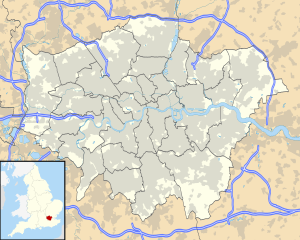Hampton Court Bridge
Coordinates: 51 ° 24 ′ 14 " N , 0 ° 20 ′ 33" W.
| Hampton Court Bridge (1933-present) | ||
|---|---|---|
| Hampton Court Bridge (2006) | ||
| use | Road traffic | |
| Convicted | Main road |
|
| Subjugated | Thames | |
| place | London | |
| construction | Arch bridge in reinforced concrete | |
| overall length | approx. 100 m | |
| width | 22 m | |
| Number of openings | 3 | |
| Longest span | 32 m | |
| start of building | 1930 | |
| completion | April 9, 1933 | |
| opening | July 3, 1933 | |
| planner | WP Robinson, Edwin Lutyens | |
| location | ||
|
|
||
The Hampton Court Bridge is a road bridge over the River Thames in London . It is the westernmost Thames bridge in the city and is located near the mouth of the River Mole . It was the first reinforced concrete bridge over the Thames.
The bridge connects the Elmbridge district in Surrey with the London Borough of Richmond upon Thames . The main road A309 runs over them . It creates a direct connection between Hampton Court train station on the south side and Hampton Court Palace and Bushy Park on the north side.
history
First bridge
There has been a ferry at this point since the Tudor period . A law passed by parliament in 1750 allowed James Clarke, operator of the ferry, to build a toll bridge. Construction of the wooden bridge began in 1752 and opened on December 13, 1753. The bridge toll was half a penny for pedestrians , and two shillings and six pence for a six-horse wagon .
Built by Samuel Stevens and Benjamin Ludgator, the 150-meter-long bridge had seven arches and was six meters wide. The pillars consisted of wooden boxes filled with stones. The bridge's peculiar design looked fragile. The roadway followed the structure of the arches, which was otherwise only known from Chinese bridges. After just twenty-five years, the bridge was so dilapidated that it had to be demolished in 1788 and replaced by a new one.
Second bridge
The second bridge on the same site was built in 1788 by a Mr. White from Weybridge . The ten-bay wooden bridge was 105 meters long and slightly shorter than its predecessor and only 5.4 meters wide. The construction cost was £ 7,000. The bridge was so sturdy that it could be used for a hundred years before it also fell into disrepair, so that Parliament demanded a new building.
Third bridge
In May 1864 the demolition of the bridge began to make way for the third bridge. She had been designed by ET Murray and was opened on April 10, 1865. The bridge consisted of a five-span wrought iron lattice girder that rested on four pairs of octagonal cast iron columns. The roadway was 6 meters wide and had a 1.5 wide sidewalk on the west side. The cost of construction was £ 11,176.
Today's bridge
At the beginning of the 20th century, the third bridge was no longer sufficient for the increased volume of traffic. In 1928 the administrations of Middlesex and Surrey Counties received approval from Parliament to demolish the third bridge and to build what is now the fourth bridge with the necessary access roads. Construction began in 1930 and included the demolition of a hotel, the diversion of the river Mole including the filling in of the old river bed, and the construction of a new access road from the south, which created a direct connection to the Kingston bypass .
The new arch bridge designed by WP Robinson and Edwin Lutyens was the first reinforced concrete bridge over the Thames. The middle of the three arches has a span of 32 meters, the two outer ones a span of 27.5 meters. The roadway is 12 meters wide and the two sidewalks are 4.6 meters each. Thus the sidewalks of the new bridge are almost as wide as the carriageway of the old bridge. The structure was clad with red bricks and natural Portland stones.
The bridge was opened to traffic on April 9, 1933 with a small celebration of the local population, the official opening took place on July 3, 1933 by the then Prince of Wales , later King Edward VIII .
Originally, the River Mole flowed into the Thames in the area of today's bridge, but this was merged with the River Ember a little further downstream when the bridge was built .
Web links
- Hampton Court Bridge. In: Structurae
- History of the Hampton Court Bridge
- Hampton Court Bridge. In: Where Thames smooth waters glide. Retrieved May 26, 2013 .
- Rowland GM Baker: Hampton Court Bridge. In: Thameside Molesey. Retrieved May 26, 2013 .
Individual evidence
- ^ A b c d e Rowland GM Baker: Hampton Court Bridge. In: Thameside Molesey. Retrieved May 26, 2013 .
- ^ East Molesey History , accessed April 3, 2016.
|
upstream Walton Bridge |
River crossings of the Thames |
downstream Kingston Bridge |




